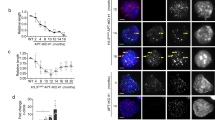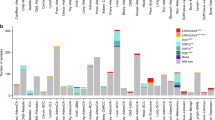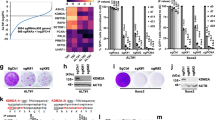Abstract
Most human tumor cells acquire immortality by activating the expression of telomerase, a ribonucleoprotein that maintains stable telomere lengths at chromosome ends throughout cell divisions. Other tumors use an alternative mechanism of telomere lengthening (ALT), characterized by high frequencies of telomeric sister chromatid exchanges (T-SCEs). Mechanisms of ALT activation are still poorly understood, but recent studies suggest that DNA hypomethylation of chromosome ends might contribute to the process by facilitating T-SCEs. Here, we show that ALT/T-SCEhigh tumor cells display low DNA-methylation levels at the D4Z4 and DNF92 subtelomeric sequences. Surprisingly, however, the same sequences retained high methylation levels in ALT/T-SCEhigh SV40-immortalized fibroblasts. Moreover, T-SCE rates were efficiently reduced by ectopic expression of active telomerase in ALT tumor cells, even though subtelomeric sequences remained hypomethylated. We also show that hypomethylation of subtelomeric sequences in ALT tumor cells is correlated with genome-wide hypomethylation of Alu repeats and pericentromeric Sat2 DNA sequences. Overall, this study suggests that, although subtelomeric DNA hypomethylation is often coincident with the ALT process in human tumor cells, it is not required for T-SCE.
This is a preview of subscription content, access via your institution
Access options
Subscribe to this journal
Receive 50 print issues and online access
$259.00 per year
only $5.18 per issue
Buy this article
- Purchase on Springer Link
- Instant access to full article PDF
Prices may be subject to local taxes which are calculated during checkout







Similar content being viewed by others
Accession codes
References
Bailey SM, Brenneman MA, Goodwin EH . (2004). Frequent recombination in telomeric DNA may extend the proliferative life of telomerase-negative cells. Nucleic Acids Res 32: 3743–3751.
Bechter OE, Shay JW, Wright WE . (2004). The frequency of homologous recombination in human ALT cells. Cell Cycle 3: 547–549.
Benetti R, Garcia-Cao M, Blasco MA . (2007a). Telomere length regulates the epigenetic status of mammalian telomeres and subtelomeres. Nat Genet 39: 243–250.
Benetti R, Gonzalo S, Jaco I, Schotta G, Klatt P, Jenuwein T et al. (2007b). Suv4-20h deficiency results in telomere elongation and derepression of telomere recombination. J Cell Biol 178: 925–936.
Blackburn EH . (2001). Switching and signaling at the telomere. Cell 106: 661–673.
Blasco MA . (2007). The epigenetic regulation of mammalian telomeres. Nat Rev Genet 8: 299–309.
Brock GJ, Charlton J, Bird A . (1999). Densely methylated sequences that are preferentially localized at telomere-proximal regions of human chromosomes. Gene 240: 269–277.
Bryan TM, Englezou A, Dalla-Pozza L, Dunham MA, Reddel RR . (1997). Evidence for an alternative mechanism for maintaining telomere length in human tumors and tumor-derived cell lines. Nat Med 3: 1271–1274.
Cacurri S, Piazzo N, Deidda G, Vigneti E, Galluzzi G, Colantoni L et al. (1998). Sequence homology between 4qter and 10qter loci facilitates the instability of subtelomeric KpnI repeat units implicated in facioscapulohumeral muscular dystrophy. Am J Hum Genet 63: 181–190.
Cadieux B, Ching TT, VandenBerg SR, Costello JF . (2006). Genome-wide hypomethylation in human glioblastomas associated with specific copy number alteration, methylenetetrahydrofolate reductase allele status, and increased proliferation. Cancer Res 66: 8469–8476.
Cerone MA, Autexier C, Londono-Vallejo JA, Bacchetti S . (2005). A human cell line that maintains telomeres in the absence of telomerase and of key markers of ALT. Oncogene 24: 7893–7901.
Cerone MA, Londono-Vallejo JA, Bacchetti S . (2001). Telomere maintenance by telomerase and by recombination can coexist in human cells. Hum Mol Genet 10: 1945–1952.
Cornforth MN, Eberle RL . (2001). Termini of human chromosomes display elevated rates of mitotic recombination. Mutagenesis 16: 85–89.
de Lange T, Shiue L, Myers RM, Cox DR, Naylor SL, Killery AM et al. (1990). Structure and variability of human chromosome ends. Mol Cell Biol 10: 518–527.
De Smet C, De Backer O, Faraoni I, Lurquin C, Brasseur F, Boon T . (1996). The activation of human gene MAGE-1 in tumor cells is correlated with genome-wide demethylation. Proc Natl Acad Sci USA 93: 7149–7153.
De Smet C, Loriot A, Boon T . (2004). Promoter-dependent mechanism leading to selective hypomethylation within the 5' region of gene MAGE-A1 in tumor cells. Mol Cell Biol 24: 4781–4790.
Der-Sarkissian H, Vergnaud G, Borde YM, Thomas G, Londono-Vallejo JA . (2002). Segmental polymorphisms in the proterminal regions of a subset of human chromosomes. Genome Res 12: 1673–1678.
Dunham MA, Neumann AA, Fasching CL, Reddel RR . (2000). Telomere maintenance by recombination in human cells. Nat Genet 26: 447–450.
Ehrlich M . (2002). DNA methylation in cancer: too much, but also too little. Oncogene 21: 5400–5413.
Ehrlich M . (2006). Cancer-linked DNA hypomethylation and its relationship to hypermethylation. Curr Top Microbiol Immunol 310: 251–274.
Flint J, Bates GP, Clark K, Dorman A, Willingham D, Roe BA et al. (1997). Sequence comparison of human and yeast telomeres identifies structurally distinct subtelomeric domains. Hum Mol Genet 6: 1305–1313.
Ford LP, Zou Y, Pongracz K, Gryaznov SM, Shay JW, Wright WE . (2001). Telomerase can inhibit the recombination-based pathway of telomere maintenance in human cells. J Biol Chem 276: 32198–32203.
Gonzalo S, Jaco I, Fraga MF, Chen T, Li E, Esteller M et al. (2006). DNA methyltransferases control telomere length and telomere recombination in mammalian cells. Nat Cell Biol 8: 416–424.
Hayflick L, Moorhead PS . (1961). The serial cultivation of human diploid cell strains. Exp Cell Res 25: 585–621.
Henson JD, Neumann AA, Yeager TR, Reddel RR . (2002). Alternative lengthening of telomeres in mammalian cells. Oncogene 21: 598–610.
Kholmanskikh O, Loriot A, Brasseur F, De Plaen E, De Smet C . (2008). Expression of BORIS in melanoma: lack of association with MAGE-A1 activation. Int J Cancer 122: 777–784.
Kim NW, Piatyszek MA, Prowse KR, Harley CB, West MD, Ho PL et al. (1994). Specific association of human telomerase activity with immortal cells and cancer. Science 266: 2011–2015.
Kim NW, Wu F . (1997). Advances in quantification and characterization of telomerase activity by the telomeric repeat amplification protocol (TRAP). Nucleic Acids Res 25: 2595–2597.
Londono-Vallejo JA, Der-Sarkissian H, Cazes L, Bacchetti S, Reddel RR . (2004). Alternative lengthening of telomeres is characterized by high rates of telomeric exchange. Cancer Res 64: 2324–2327.
Loriot A, De Plaen E, Boon T, De Smet C . (2006). Transient down-regulation of DNMT1 methyltransferase leads to activation and stable hypomethylation of MAGE-A1 in melanoma cells. J Biol Chem 281: 10118–10126.
Masutomi K, Possemato R, Wong JM, Currier JL, Tothova Z, Manola JB et al. (2005). The telomerase reverse transcriptase regulates chromatin state and DNA damage responses. Proc Natl Acad Sci USA 102: 8222–8227.
Michishita E, McCord RA, Berber E, Kioi M, Padilla-Nash H, Damian M et al. (2008). SIRT6 is a histone H3 lysine 9 deacetylase that modulates telomeric chromatin. Nature 452: 492–496.
Monfouilloux S, Avet-Loiseau H, Amarger V, Balazs I, Pourcel C, Vergnaud G . (1998). Recent human-specific spreading of a subtelomeric domain. Genomics 51: 165–176.
Nakamura TM, Cooper JP, Cech TR . (1998). Two modes of survival of fission yeast without telomerase. Science 282: 493–496.
Perrem K, Colgin LM, Neumann AA, Yeager TR, Reddel RR . (2001). Coexistence of alternative lengthening of telomeres and telomerase in hTERT-transfected GM847 cells. Mol Cell Biol 21: 3862–3875.
Riethman H . (2008). Human telomere structure and biology. Annu Rev Genomics Hum Genet 9: 1–19.
Riethman H, Ambrosini A, Paul S . (2005). Human subtelomere structure and variation. Chromosome Res 13: 505–515.
Shay JW, Bacchetti S . (1997). A survey of telomerase activity in human cancer. Eur J Cancer 33: 787–791.
Shimojima M, Komine F, Hisatomi H, Shimizu T, Moriyama M, Arakawa Y . (2004). Detection of telomerase activity, telomerase RNA component, and telomerase reverse transcriptase in human hepatocellular carcinoma. Hepatol Res 29: 31–38.
Siedlecki P, Zielenkiewicz P . (2006). Mammalian DNA methyltransferases. Acta Biochim Pol 53: 245–256.
Tilman G, Mattiussi M, Brasseur F, van Baren N, Decottignies A . (2007). Human periostin gene expression in normal tissues, tumors and melanoma: evidences for periostin production by both stromal and melanoma cells. Mol Cancer 6: 80.
Traversari C, van der Bruggen P, Van den Eynde B, Hainaut P, Lemoine C, Ohta N et al. (1992). Transfection and expression of a gene coding for a human melanoma antigen recognized by autologous cytolytic T lymphocytes. Immunogenetics 35: 145–152.
van Overveld PG, Lemmers RJ, Sandkuijl LA, Enthoven L, Winokur ST, Bakels F et al. (2003). Hypomethylation of D4Z4 in 4q-linked and non-4q-linked facioscapulohumeral muscular dystrophy. Nat Genet 35: 315–317.
Vera E, Canela A, Fraga MF, Esteller M, Blasco MA . (2008). Epigenetic regulation of telomeres in human cancer. Oncogene 27: 6817–6833.
Watson JD . (1972). Origin of concatemeric T7 DNA. Nat New Biol 239: 197–201.
Weisenberger DJ, Campan M, Long TI, Kim M, Woods C, Fiala E et al. (2005). Analysis of repetitive element DNA methylation by MethyLight. Nucleic Acids Res 33: 6823–6836.
Wilson VL, Jones PA . (1983). DNA methylation decreases in aging but not in immortal cells. Science 220: 1055–1057.
Yehezkel S, Segev Y, Viegas-Pequignot E, Skorecki K, Selig S . (2008). Hypomethylation of subtelomeric regions in ICF syndrome is associated with abnormally short telomeres and enhanced transcription from telomeric regions. Hum Mol Genet 17: 2776–2789.
Young JI, Sedivy JM, Smith JR . (2003). Telomerase expression in normal human fibroblasts stabilizes DNA 5-methylcytosine transferase I. J Biol Chem 278: 19904–19908.
Acknowledgements
We are grateful to M Swinarska, F Brasseur, W Wright, F Fuks, J Lingner, F d'Adda di Fagagna, F Journe, H Id Boufker and C Heirman for the generous gifts of cell lines and plasmids. We thank all the members of the GENEPI group for their constant support and help. This study was supported by the Fonds National de la Recherche Scientifique (FNRS), Belgium. GT is supported by a PhD fellowship grant from Télévie/FNRS. AL is supported by a post-doctoral grant from the FNRS. Work in the ‘Telomere&Cancer’ laboratory is supported by grants from ANR, ARC, INCa and La Ligue.
Author information
Authors and Affiliations
Corresponding author
Additional information
Conflict of interest
The authors declare no conflict of interest.
Supplementary Information accompanies the paper on the Oncogene website (http://www.nature.com/onc)
Rights and permissions
About this article
Cite this article
Tilman, G., Loriot, A., Van Beneden, A. et al. Subtelomeric DNA hypomethylation is not required for telomeric sister chromatid exchanges in ALT cells. Oncogene 28, 1682–1693 (2009). https://doi.org/10.1038/onc.2009.23
Received:
Revised:
Accepted:
Published:
Issue Date:
DOI: https://doi.org/10.1038/onc.2009.23
Keywords
This article is cited by
-
Targeting telomeres: advances in telomere maintenance mechanism-specific cancer therapies
Nature Reviews Cancer (2022)
-
Detection of alternative lengthening of telomeres mechanism on tumor sections
Molecular Biomedicine (2021)
-
Telomeres in ICF syndrome cells are vulnerable to DNA damage due to elevated DNA:RNA hybrids
Nature Communications (2017)
-
Selective increase in subtelomeric DNA methylation: an epigenetic biomarker for malignant glioma
Clinical Epigenetics (2015)
-
A gene expression signature identifying transient DNMT1 depletion as a causal factor of cancer-germline gene activation in melanoma
Clinical Epigenetics (2015)



